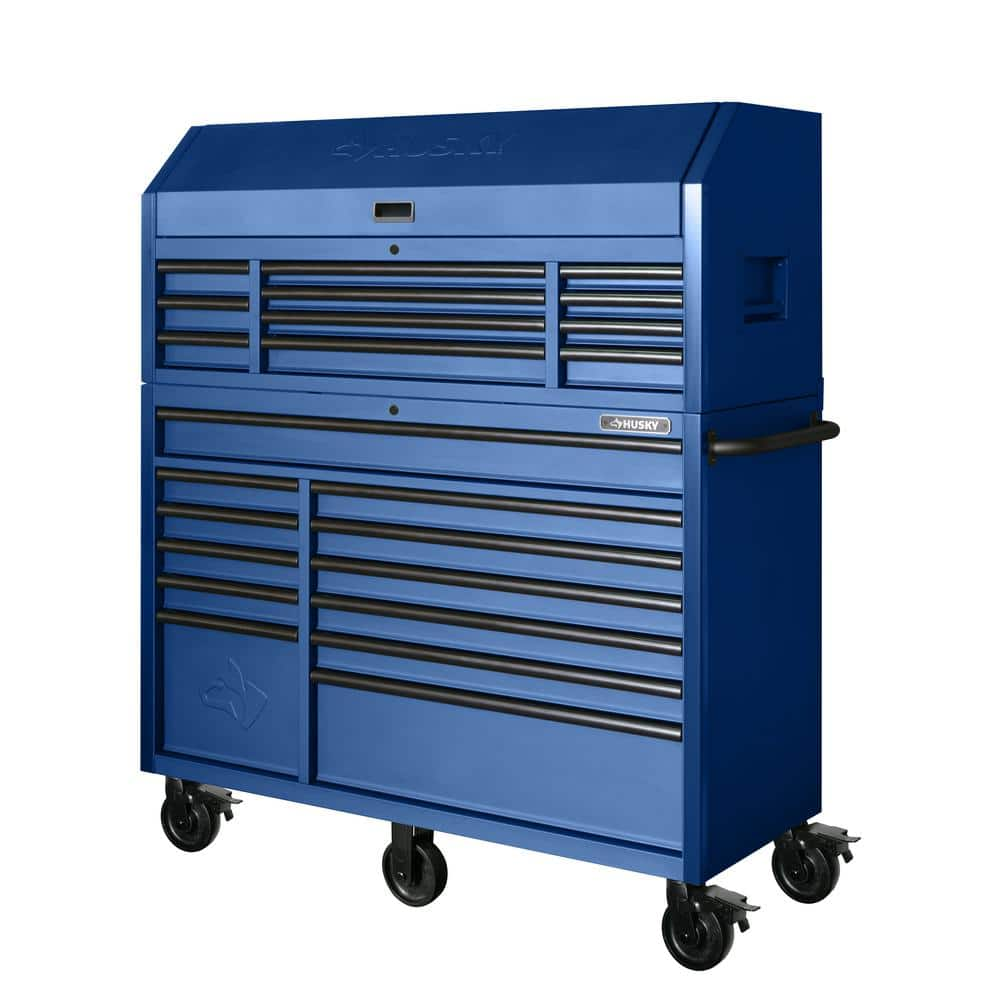Husky 56 in. W x 22 in. D Heavy Duty 23-Drawer Combination Rolling Tool Chest and Top Tool Cabinet Set in Matte Blue
Blue combo tool chest has 120 lb. rated soft-close drawer slides. Equipped with 6 casters (4 swivel with brakes and 2 fixed). Minimal assembly required: attached casters and handle.
The Husky 56 in. W, 22 in. D with 23-drawers Tool Chest and Cabinet Set is a heavy-duty, 18-Gauge steel, tool storage unit that is rated for 3,000 lbs. loading capacity. This tool chest and cabinet set with 23-drawers provide 42,930 cu. in. of storage. The heavy-duty drawers are rated to 120 lbs. each. The extra deep bottom drawers have double 120 lbs. glides. The full length drawer provides convenient storage for longer items and the small drawers keep smaller items in a confined space. Drawer liners are included to protect and keep your tools in place. The built-in full length power strip includes 8 outlets and 2 USB ports, making it easy to keep all of your tools charged. For added security, both the chest and cabinet are fitted with a key and lock system. This toolbox weighs in at 542 lbs. so the 6in. x 2 in. heavy-duty industrial grade glides with easy locking pedals are needed to smoothly role this unit around your work area.
- Packaged dimensions (comes in 2 separate boxes) chest (approximate) 60.04 in. W x 26.37 in. D x 26.35 in. H and weighs 282.6 lbs. cabinet (approximate) 60.04 in. W x 25.79 in. D x 42.5 in. H and weighs 420.2 lbs. total packaged dimensions of the tool combo 60.04 in. W x 26.37 in. D x 70.3 in. H and weighs 702.8 lbs.
- Assembled dimensions (approximate): chest – 56 in. W x 22 in. D x 23 in. H and weighs 220 lbs. cabinet with 3.25 in. W handle 56 in. W x 22 in. D x 42 in. H and weighs 342 lbs. total dimensions for the tool combo with casters 56 in. W x 22 in. D x 64.9 in. H and weighs approximately 542 lbs. total height of unit with chest lid open is 82.83 in.
- Top chest drawer dimensions: 3 left drawers and 1 right bottom drawer, 9.65 in. W x 19.88 in. D x 2.83 in. H., 3 top middle drawers 27.56 in. W x 19.88 in. D x 1.77 in. H, 1 bottom middle drawer 27.56 in. W x 17.9 in. D x 2.83 in H., 3 right top drawers 9.64 in. W x 19.88 in. D x 1.77 in. H
- Bottom cabinet drawer dimensions: 1 top full-width drawer 51.57 in. W x 19.88 in. D x 3.72 in. H, 4 left top drawers 15.15 in. W x 19.88 in. x 2.83 in. H, 1 bottom left drawer 15.15 in. W x 19.88 in. D x 12.4 in. H, 5 right top drawers 34.05 in. W x 19.88 in. D x 2.83 in. H, 1 bottom right drawer 34.05 in. W x 19.88 in. D x 9.21 in. H
- Built in power strip included to charge power tools
- 6 in. x 2 in. industrial grade, polypropylene casters (4 swivel with brake and 2 rigid) will support up to 3,000 lbs.
- 120 lbs. rated soft close drawer slides for smooth, durable operation, bottom drawers have double 120 lbs. drawer slides
- LED light included-41 in, W x .98 in. D x .7 in. H with one function
- Heavy-duty 18-Gauge steel
- Pre-cut, premium solid drawer liners and Husky embossed top mat keep your tools in place
- Tools and accessories shown in photos are not included with purchase
- Backed by Husky’s Limited 5-year Warranty.
Additional information
| Dimensions | H 64.9 in, W 56 in, D 22 in |
|---|---|
| Manufacturer Warranty | 5 Year Limited Warranty |






by Chris
Absolutely love everything about my Husky tool box! It is durable and the soft close drawers are a plus too. Love love love it!
by George
box was well packed it is heave so be prepared for that only thing i thought could be improved is the lock.
by Ronald
This is a really heavy duty tool box. Exactly what i was looking for with a good combination of large drawers and small drawers. It has the soft closing drawers so even it you try to slam them shut with heavy tools it gently close. Highly recommend this tool box with a very affordable price.
by Joeyn
Nice tool chest with lots of draws feels nice and sturdy and i even love the color.